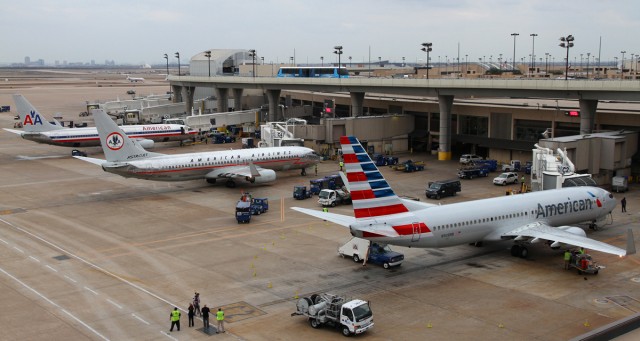
On the left is your last generation American Airlines livery. In the middle is the retro Astrojet livery (N951AA) and on the right is American’s new livery (N908NN). Photo by Joe Statz / JetPhoto.net
Joe Statz grabbed this picture of three liveries of American Airlines all lined up at Dallas Forth Worth International Airport (DFW) and was willing to share it with all of us to enjoy.
Yes. The Astrojet is an amazingly retro design, but I don’t think a fleet made to look like that today would go over too well. I think that the last American Airlines livery will also start to look more retro and classic, but again, is not a design made for 2013. I still think the new livery is surely not an evolution, but a revolution. I still like it.
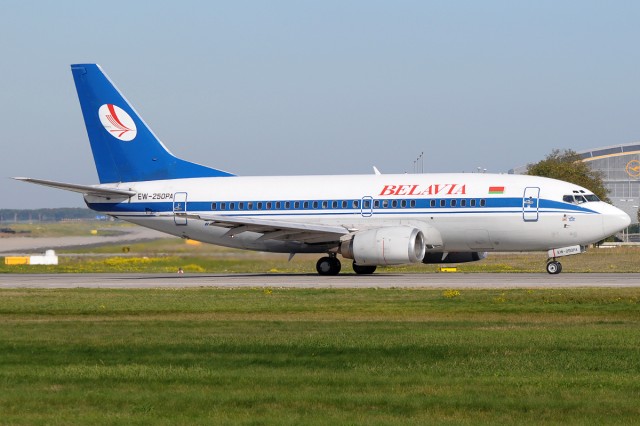
Belavia Boeing 737-500. Image from Wikipedia/CC/Biggerben.
Belavia Belarusian Airlines was founded in March of 1996 and is based at Minsk International Airport in Belarus. The airline is owned by the government and flies to destinations in Asia, Europe and Africa.
The airline currently operates a classic fleet of Boeing 737-300s, 737-500s, CRJ200s and a few Tupolev Tu-154Ms. They have two Embraer 175s and one E-190 on order in hopes to update their fleet.
Even though this is a smaller airline, they have one of the best fleet pages I have seen. You are able to check out external and internal 360 tours and I have to admit that I spent quite a bit of time taking a tour of the Tu-154M.
The livery is one of the few left that remind me of the classic Aeroflot livery. You do not see many liveries that have a cheat-line anymore — they are a dying breed.
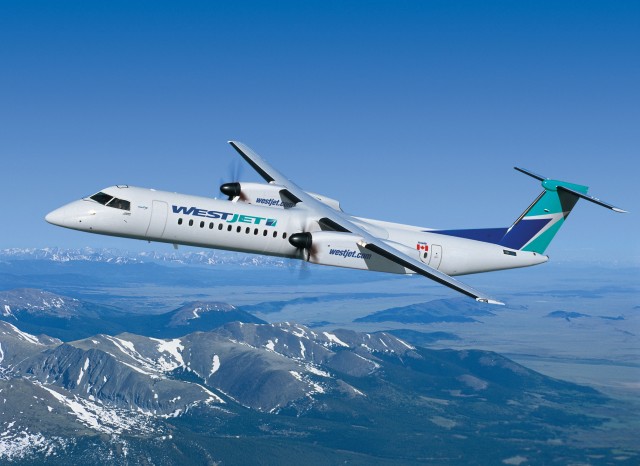
What WestJet’s new Bombarider Q400 will look like. Image from Bombardier.
WestJet has announced their plan to start a regional airline using Bombardier Q400s. This is by no means breaking news, but a story that somehow I missed and have been playing catch up and wanted to share some of the things that I have learned.
For those of you who might not be aware of WestJet, they are a low cost carrier, based at Calgary International Airport (YYC) in Alberta, Canada. Previously, they only operated a fleet of Boeing 737 aircraft in an all-economy layout.
In January of this year, WestJet stated that they were looking into starting up a smaller subset of their almost 100 fleet of 737s. At the time, WestJet President and CEO, Gregg Saretsky, stated, “A short-haul aircraft combined with WestJet’s brand, balance sheet strength and low-cost structure will allow WestJet to profitably accomplish four main goals: Introduce WestJet’s friendly and caring service to many smaller communities who have asked for our service; optimize the size of aircraft to efficiently increase frequency; create new connections between existing WestJet markets; and build additional feed to our current 71-city network so that we can continue to profitably grow and add shareholder value.”
The airline’s management talked with employees and in February, the airline announced that 91% of employees voted in favor to launch the regional airline. I would imagine that WestJet employees do not have a union is one reason the high number.
Then, the fun part came; which aircraft to buy? Although the photos of the Bombardier Q400 in WestJet livery on this story gives away the answer, they were also considering the ATR 72-600.
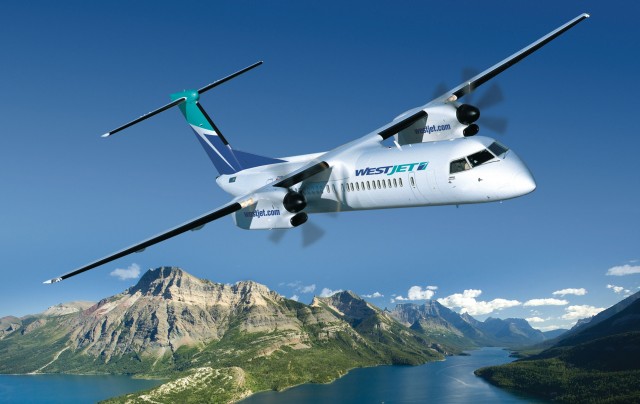
What WestJet’s new Bombarider Q400 will look like. Image from Bombardier.
“We are very impressed with the Q400,” Saretsky stated in a press release. “Both ATR and Bombardier put forward excellent proposals and ultimately we believe the Bombardier Q400’s combination of range, speed and seat density is the best choice to meet the needs of the market and how we plan to operate the regional airline.”
WestJet signed a letter of intent to purchase 20 Q400s with the option to purchase an additional 25 aircraft. The airline hopes to start regional service in 2013.
I was curious how the new Q400s would operate in the WestJet fleet and would there be a different customer service product on the Q400?
“The two airlines will operate under separate certificates. However, they will both be WestJet in every respect — culture, guest experience and even livery,” Robert Palmer, spokesperson for WestJet explained to AirlineReporter.com.
The Q400s will be used on flights lasting about one to two hours and the 737s will fly on longer routes. Both airlines will cover domestic and trans-boarder flying and the Q400s will act as a feeder system for the mainline 737s. Palmer also stated that the Q400s might be placed on current routes that have less demand and free up a 737 for additional service.
On top of starting regional service, WestJet has also stated that they will start offering premium economy seating. Each aircraft will have four rows of seats with 36″ of seat pitch and the addition of priority boarding and complimentary on-board amenities.
With Southwest Airlines flying to larger airports and bringing on the 737-800, Allegiant going from one aircraft type to three and WestJet adding regional service and premium seating, it is anyone’s guess what these low cost carriers will do next.
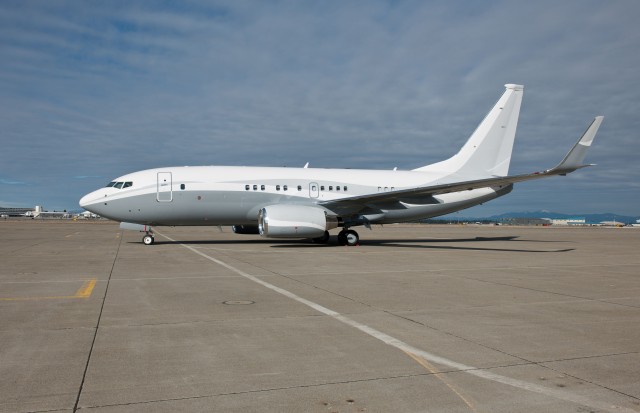
The exterior of the new Boeing Business Jet 737. Hi-Res, click for larger. Photo from Boeing.
The Boeing Business Jet (BBJ) is one awesome machine. The airplane is a 737-700 with the wings and landing gear from the 737-800. This provides the ability to carry up to nine fuel tanks and gives the aircraft additional range. The biz jet is capable of going up to 5,600 nautical miles at Mach 0.80. Yea, all the facts are interesting, but what interests me the most are the photos of this aircraft.
The first version of the new BBJ was delivered to a private businessman from the US in early March after it went through interior modifications at Jet Tech, located in Spokane, WA.
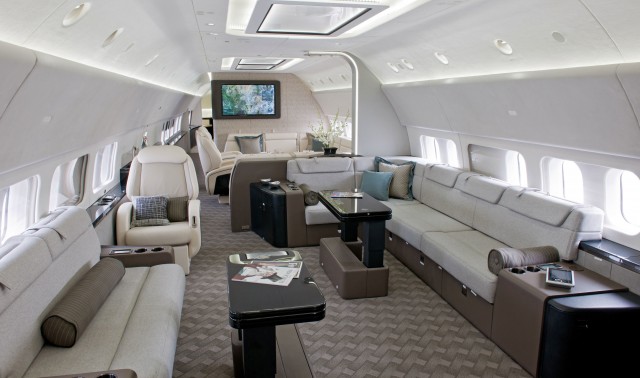
Not too shabby. The interior of 737 BBJ. Hi-Res Image: click for larger. Photo by Boeing.
This BBJ is the second for the customer. “Our repeat customers aren’t limited to governments and charter companies, but include private individuals who love the comfort and capability of their BBJ so much, they buy another one,” said Captain Steve Taylor, BBJ president.
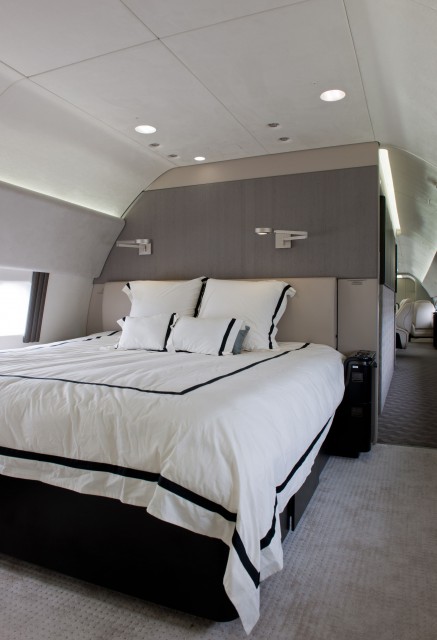
The master bedroom of this 737 BBJ. Hi-Res photo: click for larger. Photo by Boeing.
This aircraft is configured to carry only 19 passengers. Knowing that the commercial version can be configured to carry up to 149 passengers, that means this BBJ has plenty of space for each person.
According to Boeing, the aircraft, “has all the amenities of a home including a large personal stateroom with a king-size bed, private lavatory and shower. It also has a smaller guest stateroom with divans that convert into beds enabling the BBJ to sleep up to 8 passengers.”
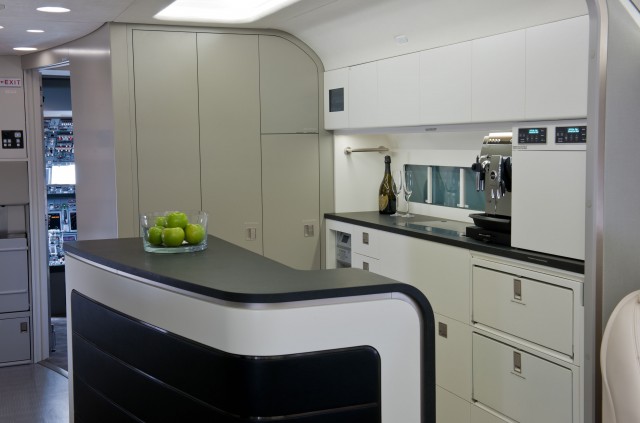
One could get a lot of good cooking done in this kitchen in the BBJ 737. Hi-Res Image: click for larger. Image by Boeing.
In the well appointed kitchen, there is island, convection/microwave ovens, a refrigerator, wine cooler and trash compactor — not too shabby.
The BBJ starts out at $57million, which is not cheap and will that will only get you the airplane. Most customers will spend an additional $20-25million on the VIP interior. Of course, this is chump change compared to get the Boeing 747-8VIP, which is listed at about $300million and costs, on average, $140-250million for the interior. Better start saving now.
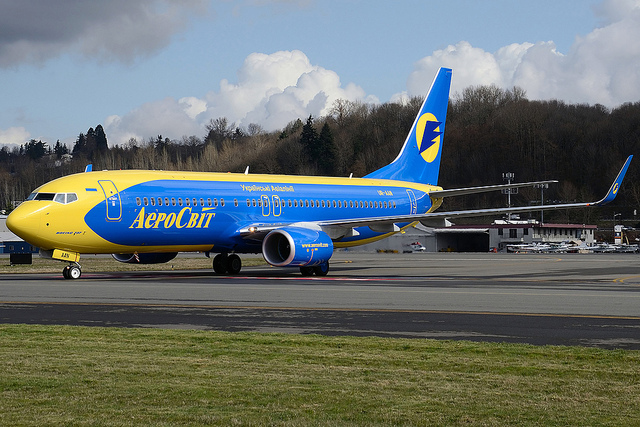
Aerosvit Boeing 737-800 (UR-AAN) seen at Boeing Field. Click for larger. Photo by Andrew Sieber.
While recently driving down I-5, passing Boeing Field, I couldn’t help but notice a Boeing 737 with a bright yellow nose and I wondered what airline it belonged to. It did not take long to find that it belongs to the Ukrainian based airline Aerosvit.
My own experience goes to show how much this livery pops out. Driving by Boeing Field (south of Seattle), one is often treated to Boeing 787s, 747s, 737s and a lot of other aviation eye candy. It takes a special livery to really demand attention — and I have a feeling that was the intent.
I am always a fan of an airline that is not afraid to go with a bold livery and I think Aerosvit did a great job with this one, especially considering their old livery was a bit bland.
Aerosvit Airlines has been in operation since 1994 and currently serves over 70 destinations. It is part of the Ukrainian Aviation Group, which also includes Dniproavia and Donbassaero (which both have similar, yet very different liveries — click on the airline’s name to see).
Aerosvit operates a fleet of Boeing 737-300s, 737-400s, 737-500s and 767-300ERs. Soon, they plan to take delivery of seven Boeing 737-800s and four Boeing 737-900ERs. With-in the Ukrainian Aviation Group, Aerosvit also has access to Airbus A320s and soon a few Embraer E-190s.








